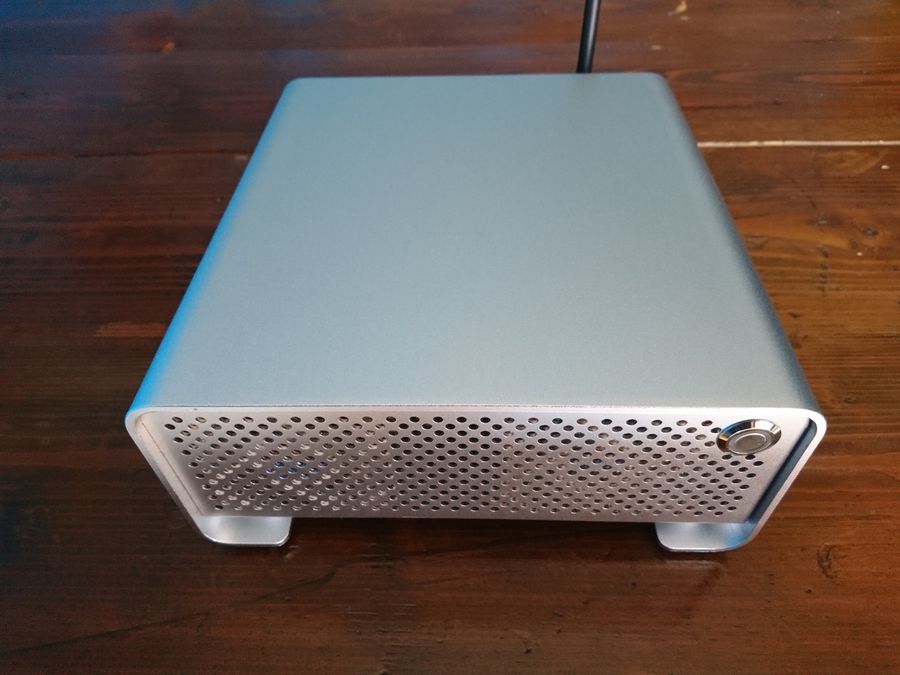Nov 18,
2018
New Desktop
Good day random Websurfer!
I think I've mentioned before my aging desktop1, anywho after learning a few months ago that recent mainline kernels have support for the new AMD's Ryzen APUs2 I proceeded to an impulse purchase, so I'm here describing my new shiny SSFF PC (seriously small form factor personal computer).
Instead of my last desktop, this one is a real desktop in the literal sense of the word. I would never dare to put the old behemoth on any desk, it's a metal box of nearly 54 liters of volume, but inside it's basically empty. The chassis contains only a really under-powered passively cooled Nvidia GPU, a 2.5 inches SSD and a DVD writer, but nonetheless it still weights a lot.

The new case instead is really tiny, around 3.5 liters of volume, for comparison the volume is sensibly smaller than a Sony's first generation PS43.
Case not closed
The case pictured above is only sold by shops in China, so other than the shipping time I had to wait five weeks before it was cleared by customs, with included request of proof of purchase. That was quite an hassle.
It's manufactured by a firm named Metalfish and the model is the "Metal Gear Plus", a name not easily searchable on the Interweb, so for the interested reader I'll add a link to their shop on TaoBao. Unfortunately the only color available is silver.
I should add that the impulse purchase resulted in a very slick but unsuitable HTPC anodized black aluminium case, a Streacom F1CWS. I've put a few pictures of it on the gallery below. Looking at the specs the case should been compatible with a Ryzen 5 2400G, but I should had known better than to take specs at a face value. When all the cores switch to burst mode, there's no way that the APU is producing only 65 W of heat.
On the other hand, the case manufacturer was quite optimistic of the cooling capacity of a single 60 mm case fan.
The cautionary tale is, the Streacom case without modifications isn't adequate for housing that CPU model, and I can't find a laser cutter or a CNC router to cut a grid on the top lid to install a 120 mm chassis fan, as it seems no one want to lend me high-power tools. Listen people, that incident with the soldering iron happened long time ago4. Anywho, the F1CWS is too fine looking to get rid of it so I've decided to keep it for an eventual future project.
I should also add that the Cryorig C7, a small profile CPU cooler, isn't compatible with either case: the nuts that are used to anchor the cooler to the motherboard are too high for the motherboard's stands used on the Streacom F1CWS and the heatsink and fan are a couple of millimeters too high for the Metalfish MetalGear Pro.
The quest for silence
I'm quite happy with the external 160 Watt PSU as it's fanless and without coiling whine of any sort, has enough headroom to power the components plus the eventual external peripherals that I would attach.
On idle and light usage the PC is completely inaudible in a really quiet room, I can't hear the CPU's fan at all. Unfortunately it became quite noisy when the four cores go full tilt for more than ten minutes, like when compiling a big application, because there isn't enough air circulation inside the case and the fans need to spin at maximum speed to avoid thermal throttling. With a room temperature around 21°C they barely keep the CPU core sensor below 77°C.
The future plan is to mod the chassis, carving an opening at the bottom to create clearance for the slightly bigger Cryorig C7 CPU cooler, to reduce air turbulence and increase fresh air intake. If it's not clear from the pictures, the motherboard is installed upside down. To be honest I have some concerns that fluid bearings fans aren't designed to work face down.
On the software front, only beginning with vanilla kernels 4.17 and using the new AMD GC - Graphic Core - drivers the system started to work with the integrated GPU, but it still randomly froze on boot nearly 3 times out of 5, it was really frustrating. According to what I read online, it's mostly related to the motherboard firmware, or better which version of AMD's AGESA the BIOS includes. I'm not sure if a later motherboard firmware update solved the boot issue or it was a driver revision, but nowadays the system is working rock solid, no complaints from my part.
Finally, the mandatory photo gallery is available below; I've thrown a PS4's DualShock controller to give an idea of the scale and also put the two desktop side by side for comparison.
-
APU is the marketing name used by AMD for a CPU with an integrated GPU ↩
-
I'm cheating a little as I'm not counting the volume of the external AC/DC PSU, and it's dramatically bigger that the usual phone charger ↩
-
didn't burned down an house, I only triggered the surge protector when I let the hot tip roll over the power cord ↩